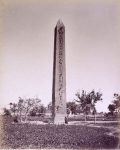Heliopolis
Archaeology »
Archaeological Monuments » Heliopolis
Heliopolis - Egypt
Heliopolis is located in Cairo.
Heliopolis monument was established on 1930 BC.
Primary threats to Heliopolis :
The ancient city of Heliopolis, the city of on in the Bible, was the chief town of the 13th name of Lower Egypt.
Historical facts of Heliopolis :
- Heliopolis, also known as "On" in ancient times, is an ancient Egyptian city with a rich history that spans over thousands of years. Located near modern-day Cairo, Heliopolis holds great significance in Egyptian mythology, religion, and architecture. Let's delve into the historical facts of Heliopolis.
- Ancient Origins :
Heliopolis was established during the Predynastic Period of ancient Egypt, around 3100 BCE. It was dedicated to the worship of the sun god Ra, considered the most important deity in the Egyptian pantheon. The city's name "Heliopolis" is derived from the Greek words "helios" (sun) and "polis" (city), emphasizing its association with the solar cult.
- Heliopolis continues to be a site of archaeological interest and preservation. Efforts are being made to protect and restore its ancient ruins, ensuring that the legacy of this once magnificent city is preserved for future generations.
- In conclusion, Heliopolis holds a significant place in ancient Egyptian history. As a center of worship, learning, and cultural exchange, it played a crucial role in shaping the religious and intellectual landscape of ancient Egypt. Today, its remnants stand as a testament to the grandeur and cultural achievements of this a
- Religious and Cultural Center :Roman and Byzantine Period :
With the arrival of the Roman Empire, Heliopolis underwent significant changes. The Romans incorporated the city into their administrative system and constructed new buildings and monuments. During the Byzantine era, Christianity gained prominence, and Heliopolis became an important Christian center with the construction of churches and monasteries.
- Decline and Rediscovery :
As the centuries passed, Heliopolis gradually declined in importance. The rise of Alexandria and the shifting course of the Nile contributed to its decline. By the Middle Ages, the city was largely abandoned and fell into ruins. However, its significance in ancient history was never forgotten.
- In recent times, archaeological excavations have uncovered the remai
Throughout its history, Heliopolis served as a major religious and cultural center in ancient Egypt. It was the birthplace of many creation myths and theological concepts. The Egyptians believed that Heliopolis was the spot where the first mound of earth emerged from the primordial waters, symbolizing the creation of the world.
- Great Temple of Heliopolis :
At the heart of Heliopolis stood the Great Temple of Heliopolis, also known as the Temple of Ra. This magnificent structure was dedicated to the worship of Ra and was one of the most important religious sites in ancient Egypt. It housed numerous shrines, obelisks, and statues depicting various gods and pharaohs.
- Knowledge and Education :
Heliopolis was renowned for its ancient wisdom and scholarship. The city was home to the renowned Heliopolitan School, where priests and scholars studied astronomy, mathematics, medicine, and philosophy. It was a center for intellectual pursuits and attracted students and scholars from all over ancient Egypt.
- Obelisks of Heliopolis :
Heliopolis was famous for its impressive obelisks, towering
- ns of Heliopolis, shedding light on its glorious past. The discovery of ancient temples, tombs, and artifacts has provided valuable insights into the religious and cultural practices of ancient Egypt.
stone pillars with hieroglyphic inscriptions. These obelisks were not only architectural marvels but also served as religious symbols. One of the most famous obelisks of Heliopolis is the obelisk of Senusret I, now located in the Hippodrome of Istanbul.ncient city.

